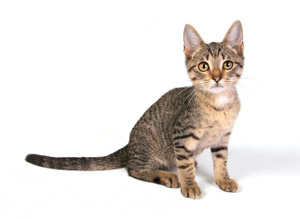If you have a new kitten or see something odd in your cat’s fecal matter, you may be wondering about worms. Worms are a parasitic organism that many cats get. The two most common kinds of worms are tapeworms and roundworms, and the symptoms of worms in cats usually is seeing tapeworm segments in the fecal material.
The first step you must take is identfying the type of worms that your cat has.
- Tapeworms are long, flat worms composed of multiple segments. What you will see if your cat is infected with tapeworms are white wormlike things moving around your cat’s rectum. These are alive segments from the tapeworm that have broken off from the adult parasite. When these segments are dead, they’ll look like uncooked rice grains or sesame seeds. You may find them where your cat sleeps.
There are two different kinds of tapeworms; each kind infects cats differently. Dipylidium caninum infects cats when they swallow a flea infected with the parasite. Taenia taeniaformia infects cats when they ingest a rodent that has been infected with this kind of tapeworm.
The best way to prevent Dipylidium caninum is to keep your cat as flea free as possible. Groom your cat frequently so you’re aware of a flea infestation. Keep your cat indoors if you can to prevent a flea infestation. Products like Frontline and Advantage for Cats are great at preventing flea infestation. And without fleas, you, your cat and your family will be much happier. On the plus side, humans usually do not become infected with tapeworms from their cat–humans also need to swallow an infected flea to become infected. Symptoms for humans and pets are similar–seeing tapeworm segments in fecal material.
To prevent Taenia taeniaformia, keep your cat indoors so they can’t play and ingest wild rodents.
Treatment for tapeworms is fairly easy. An oral medication or an injection is usually all that’s needed to kill the worms and get them out of your cat’s intestinal tract.
- Roundworms are the most common type of parasitic infection. These worms are 2-4 inches long, thin with tapered ends (think spaghetti). Cats may actually vomit these worms or pass them whole in their stool. Like tapeworms, there are two different kinds of roundworms and two different infection routes. Toxascaris leonina are transferred via feces to other cats and rodents. The other kind of roundworm, Toxocara cati is passed from mothers to their kittens via the milk the mother produces. It’s assumed that the majority of kittens are infected with roundworms. Symptoms include a potbelly in kittens, vomiting, diarrhea and possibly lethargy.

Roundworms can be transferred to humans via fecal material and if the roundworms are in the soil your cat defecated in (wear gloves while gardening). Roundworms in humans cause an infection called visceral larva migrans. Roundworms transferred by pets usually do not go into the intestines, but into other tissues such as the heart and lungs. A common type of roundworms are heartworms; heartworms can be prevented by avoiding mosquitoes. It is very important to prevent heartworms in cats, as there is no effective treatment for feline heartworms.
Mild human roundworm infestations are usually symptom-free. In heavier human infestations, the symptoms might be fever, irritability, abdominal pain, itchy skin lesions similar to hives, coughing, shortness of breath, wheezing, and if eyes are infected, loss of vision.
Treatment for roundworms is fairly easy as well. A pill normally works to take care of roundworms. Many vets recommend deworming kittens every couple of weeks whether or not you actually see worms, just to be on the safe side.
To prevent roundworm infection when your cat is older, don’t let them hunt birds and rodents. Isolate your cat from kittens and strays to prevent reinfection. Consider keeping your cat indoors to prevent them from hunting and eating rodents and birds without you being aware of it.
These are the most common types of worms in cats.
If your cat is infected with worms, you will probably have to give them a pill to kill the infestation. The best way to learn how to give your cat a pill is to have your vet, or a veterinarian technician show you. But the following are a few tips on how to give your cat a pill.
- Tilt your cat’s head backwards, and using the forefinger of the other hand, open the lower jaw, and place the pill as far back into the mouth as you can.
- Hold your cat’s head in a normal position and stroke the throat until the pill is swallowed.
- Squirting a few millimeters of water into your cat’s mouth using a plastic syringe may help your cat swallow the pill.
- You can try to hide a pill in your cat’s favorite food, but most cats will eat around the pill and then spit it back out.
- When giving your cat a pill, move fast and give your cat lots of love (if they’ll accept it) afterwards.
